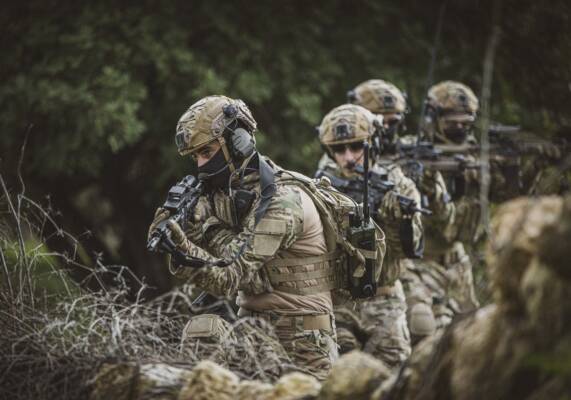
Tel Aviv. Rafael Advanced Defense Systems (RADS) has completed the second phase of Germany’s Transparent Battlefield study and performed a demonstration of its BNET advanced SDR communication and its Fire Weaver sensor to shooter system for the German Army.
The event took place in Paderborn, Germany, in November 2020, in front of representatives from the Bundeswehr and various partners and industries.
The Second Phase demonstration of the Transparent Battlefield study included live traffic from the Aeronautics Pegasus Drone, along with the Fire Weaver Sensor-to-Shooter system, all carried over the BNET advanced Software Defined Radio (BNET Hand-Held and BNET Vehicular). The demo was hosted by Atos Information GmbH, which acts as the prime contractor for the Transparent Battlefield Study, and included its C2 software as an integral part of the demo.
BNET is a Spectrum-Aware SDR – utilizing the spectral arena of the battlefield to the fullest in a cognitive way, using Multi-frequency Channel Reception (MCR), which enables it to receive and analyze information from numerous frequency channels, simultaneously, using a single RF head.
Fire Weaver is a networked sensor to shooter system which provides the tactical forces with a GPS-independent geo-pixel-based tactical common language among all the sensors and shooters, providing optimal situational awareness and improved understanding of the battlefield. Fire Weaver uses Rafael’s advanced artificial intelligence algorithms, processes the battle data, analyzes it, and prioritizes fire allocation.
As was published in December 2019, Rafael has partnered with Atos Information GmbH on a project involving the creation of a program named “Transparent Battlefield”, in which unmanned aerial systems and combat vehicles are used to create a 3D picture of mobile operations in real-time. The work will be performed for the German Federal Office of Bundeswehr Equipment, Information Technology and In-Service Support. Following the completion of the first and second phases, further phases are expected to take place in the coming years.
Mr. Yoav Wermuth, VP and head of RAFAEL’s C3I directorate said: “Today’s battlefields are undergoing far-reaching changes that affect the operational needs of land, air and naval forces, with newly emerging real-time applications, such as sensor-to-effector cycle closure systems. Rising to meet these challenges, and relying on decades of experience in the development of C4I solutions, Rafael has developed the BNET Family, enhanced with patented technology, and the Fire Weaver, a high-precision, three-dimensional, GPS-independent common visual language system.
Integration of these systems into the Bundeswehr will lead to a number of significant changes – it will provide a common visual language among different types of units, not only from the Bundeswehr, but also from allied forces, which share the same threats and missions, connecting multiple sensors and shooters on one single “flat” network.”
In 2019, The Indian Air Force has begun to integrate the Rafael BNET software defined radio on all its combat aircraft. The Israeli company is supplying 1,000 systems that will be integrated into all the Indian Air Force combat aircraft.
The BNET is the main communication system of the Israeli air force (IAF) existing and future platforms. The BNET system replaces existing radio systems installed in aircraft and according to the Israeli company while half in size and weight, it offers a very wide communications channel for data.
According to Rafael, the SDR system optimizes the spectrum utilization, while the use of advanced waveforms deliver high speed networking, supporting live video, image transfer, voice and data.
According to Rafael the BNET communications systems have been selected by the air forces of Brazil and Columbia and is now competing in other countries.
Rafael says that the BNET allows the aircraft to achieve a fully networked communication system between airborne platforms and ground a naval forces. The system is seamless and it allows the transfer of data including video images in unprecedented rates.
Rafael says that the use of ad-hoc networking optimizes the spectrum utilization, while the use of advanced waveforms deliver high speed networking, supporting live video, image transfer, voice and data. Reliance on SDR also ensures ‘future-proof’ upgradability and interfacing with legacy systems.
According to RAFAEL, the system that has been selected is based on a new family of SDR systems developed by the company in recent years.
RAFAEL began the development of BNET as a ground based network, and later adapted the system for airborne and air-ground applications. RAFAEL has transferred considerable elements of the system development and production to India, enabling local partners to share a major part of the program in the current phase and also benefit from its future spinoffs.
According to RAFAEL, the efficiency of BNET as an adaptable network means that the airborne communications could provide in the future the basis for advanced terrestrial communications, supporting land-based applications as well.
-The writer is an Israel-based freelance journalist








